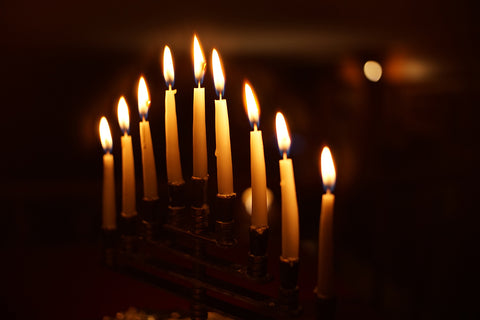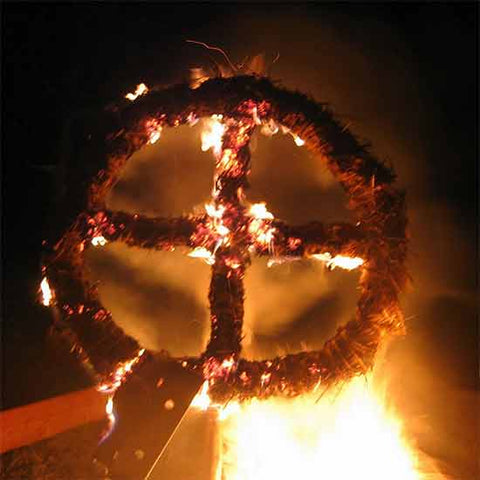February 26, 2019 0 Comments

Since fire was first domesticated about one million years ago, humans have attempted to harness its power in any way possible, often with disastrous consequences. Fire is simultaneously transformative, destructive, fearsome, beautiful, and hypnotic. It is no wonder that its awesome presence has been a central component of worship since time immemorial.
Fire and candle worship are ubiquitous in world religions, both ancient and modern. In the fifth century BCE, the Athenians would hold a procession to the sanctuary of the goddess Artemis Mounichia, and offer her round cakes with a candle in the middle, which some have hypothesized is the origin of the birthday cake tradition. The Mounichia festival occurred on the 16th of the spring month Mounichion, during the full moon.

The goddess Artemis Mounchia, also referred to as Diana and sometimes Athena
Fire is one of the most central components of Zoroastrianism, in which prayer occurs in the presence of fire or sunlight, or in houses of worship called fire temples. The Parsis view fire as the physical expression of Ahura Mazda, the sole deity of Zoroastrianism.
Fire has played a significant role in European and Nordic festivals tracing back to the middle ages. Bonfires were used for sacrificial purposes, to celebrate the first Sunday in Lent, and to mark the Winter Solstice. In Germany, France and Switzerland, bonfires and torches were lit throughout the peasant villages surrounded by dancing and singing. Young children would leap over the fire embers in hopes of securing good crops, a happy marriage, and to protect them from various evil spirits. In Norse Yule celebrations, light was used to counter the darkness of winter. Bonfires were lit to make sacrifices for the dead, to wish for a good new year, and to mark the gradual brightening of days.

In Judaism, candles have been featured prominently in ritual. Jews mark the beginning of Shabbat (the Sabbath) by lighting twin candles at dinner every Friday night. When Shabbat ends at sundown on Saturday, worshippers light the havdalah candle, a special braided candle with two or more wicks to mark the ending of the Sabbath and the beginning of a new week. Lighting candles is also a central component of Hanukkah, a Jewish festival commemorating the Maccabean Revolt. During Hanukkah, Jewish people light a special candelabrum, a menorah, which consists of nine branches.

Above, a braided Havdala candle. Below, a menorah.

Votive candles, or prayer candles, are used prominently in many denominations of Christianity. Candles are integrated into various ceremonies as a sacred way of honoring martyrs and to represent the divine light of God. In Catholicism, candles are placed in front of statues of Jesus or the Virgin Mary during most ceremonial and liturgical events. Light is used primarily as a representation of joy and salvation, symbolizing the presence of God. In many Scandinavian countries, such as Sweden, St. Lucia’s Day is celebrated by crowning a young girl in a wreath of candles on December 13th. As well, an "advent spiral" is a modern way to celebrate advent and the winter solstice.

Above, an advent or solstice spiral. Below, traditional garb for the celebration of St. Lucia.

During the Hindu festival of Diwali, which occurs every autumn (in the Northern Hemisphere), worshippers celebrate the “victory of light over darkness, good over evil and knowledge over ignorance” by illuminating their homes, temples, and shops with candles.
In Buddhist ritual observances, candles are placed before shrines or images of the Buddha as a show of respect, often accompanied by food and drink. The light of the candles represents the light of the Buddha's teachings, echoing the metaphor of light used in various Buddhist scriptures.

Lighting Indian earthen clay lamps during Diwali.
Within African American culture, candles are used to celebrate Kwanzaa. Between December 26th and January 1st, a candelabrum called a Kinara holds seven candles of different colors to represent the African American people, their struggles, and their hopes for the future. (1)
Candles have been independently re-invented throughout history. Ancient candle making is attested from ancient Egypt, Rome, and Greece, among others, though the earliest surviving candles originated in Han China around 200 BC. Although for most of history candles were made from tallow (animal fat) or beeswax, the most common wax used in candle making is now paraffin, a byproduct of petroleum production. Other substances used in candle making over time have included spermaceti (a wax derived from sperm whales), microcrystalline wax, stearin, plant waxes, and gels.
Going as far back as the Paleolithic era, candle magic has been used primarily as a form of ritual, meditation, and invocation, and many ancient European traditions involved fire in their seasonal spiritual practices. In Wicca, a modern neopagan tradition blending ancient germanic, druid, and celtic practices, candles are used for spells and rituals of every kind, each with corresponding properties and colors. The colors of candles also correspond to different Zodiac signs, each with their own primary and secondary candle color. The color red, for example, represents courage, health, sexual love, strength and vigor, whereas brown represents hesitation, neutrality, and uncertainty. The Zodiac sign of Aquarius corresponds with the colors blue and green, and Sagittarius with gold and red.
Any type of candle can be used for candle magic as long as it has been cleansed and consecrated prior to use. This cleansing is done to remove any negative energy or psychic debris the candle may have picked up along the way. The use of candles in Wiccan magick is categorized as “sympathetic magic,” which means that the candle is representative of a person’s desires. The use of this kind of magic is meant to solve problems presented by twentieth century living. It is the idea that by burning candles and manipulating them in various ways that we can influence people and things. In addition to the color of a candle, they must be adorned and “dressed” properly depending on the ritual. Typically there are four categories of candles: altar candles, offertory candles, astral candles, and day candles. Each of these candles reflect the date or time, as well as the intention of the practitioner.

In Meditation practices, candles have been used to bring one to a greater state of awareness, attention and focus. Trataka, for example is a yogic practice that involves staring at a single point such as a small object, or candle flame. The practice is meant to bring energy to the third eye chakra and promote various psychic abilities. It is through fixing our gaze upon the flame that our minds come to a halt and we are able to bring ourselves to a greater state of awareness.
Similarly in Buddhist practices, candle use is meant comprise mental states such as calm, concentration, and one-pointedness (which comprises the six forces: hearing, pondering, mindfulness, awareness, effort and intimacy). These practices are also echoed in scrying, a neopagan divination practice used for finding insight and wisdom through staring into a flame or reflective object such as a water vessel or crystal.
Throughout history, the significance of candles and light have transcended the purpose of illumination. Whether it be for purpose of conjuring, sanctifying, purifying, or centering, candle usage has been ubiquitous as a source of uplifting and connecting the human spirit to higher sources of wisdom, spirituality, and connectedness. No matter what the tradition or lense through which you incorporate candles, it is through the flickering of a single flame that each of us can somehow find a way to return to the oneness of the universe.
Sources:
In addition to sources linked in the article:
(1) Peek, Philip M.; Kwesi Yankah (2004). African Folklore: An Encyclopedia. Taylor & Francis. pp. 201–203.
(2) Bhagwan Shree Rajneesh, Dynamics of Meditation, Bombay, India, 1972, pages 271-3 [1]
Mallory Ditchey is a Yale and Columbia educated scholar, a college prep and at-risk-youth tutor in the Los Angeles area, and a total punk rocker.
Livya Howard-Yashar graduated from Sarah Lawrence College with a focus in cultural anthropology. A native to Los Angeles, she is a freelance writer, educator, musician, and dancer/choreographer. She has performed around the world, holding workshops and residencies, and currently works in Los Angeles as a performance and writing coach.
Read more on astrology, horoscopes, occultism, magick & ritual on our blog, Esoteric Insights!
April 26, 2024 0 Comments
Ahhh- the enchanting realm of May Day! A time when flowers bloom in riotous colors, the air vibrates with flickers of summer, ancient traditions stir beneath the surface of the earth, and the promise of new beginnings pulsates around us. From April 28 through May 5, we stand on the threshold between spring's awakening and summer's embrace, Beltane, the spirited celebration also known as May Day. Let us embark on a journey through time to uncover the ancient origins and cultural tapestry of Beltane, from the blazing bonfires of the Celts to the floral splendor of English Flora Day, this magical time of year has a beautifully rich history and diverse multitude of ancient traditions.
February 13, 2024 0 Comments
February 05, 2024 0 Comments